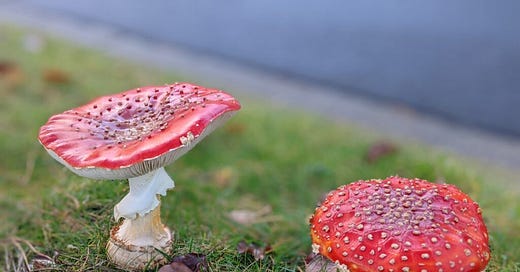Hey Fungi Friday fam,
Light week in mushroom news, but there were two articles that stuck out. One on the importance of these specimen in supporting life as we’ve come to know it. And a second, highlighting the positive sentiment building behind the budding psilocybin industry. Let’s dive in!
The network of life depends on fungi
Ever see a tree rooted in solid granite, or some other type of rock structure and wonder how it managed to survive there? Two words: Fungal Networks. Unlike tree roots, fungal networks can penetrate deep into the weathered rock, extracting water and nutrients to feed the tree. These enzymes and acids also process nutrients such as nitrogen, phosphorus, iron and calcium, making them available to the tree.
A robust network is at the root of any effective distribution system, be it for information or products. Further back than any of us can remember, trees have been tapping into powerful hidden networks to become one of the most widespread and resilient life forms on Earth. Vegetative bodies of fungus in the soil’s surface join in spider web systems called mycorrhizae to form the largest networks on the planet. How do these networks benefit the trees, and how does their mutual association affect the ecosystem as a whole?
When tree roots are coupled with mycorrhizal networks they become infinitely more powerful, capable of moving excess water and nutrients from one location and redistributing these resources to thirsty plant life in another.
And for all the benefit that these trees get, what do the fungi get in return? In the network of our ecosystem, trees give as much as they take, providing the fungus with water, carbon, and complex sugars.
During drought, the deep roots of trees access groundwater that the surface-dwelling fungus cannot reach. Powered by the daytime sun, the tree draws up water through photosynthesis. When the sun sets, photosynthesis ceases, but the tree’s cells remain full of water. When the soil around the tree is dry, the water stored in the tree’s cells flows out through the roots and is redistributed by the fungal network. That’s why plants stay green longer near deep-rooted trees.
Not only do trees deliver water to their mycorrhizal associates, but they also provide them with the carbon and complex sugars that the fungus need to grow. A 2014 study led by Michael Allen at the University of California, Riverside, demonstrated that 20 to 35% of the carbon sequestered through the photosynthetic process of oak trees in California was handed over to mycorrhizal fungi—both the trees and their fungal associates are sequestering carbon.
The underground associations between trees and fungus are only part of the complex networks that allow ecosystems to thrive. From bears and humans who harvest fish from rivers under shade of a tree. Deer and cattle feed on the plants watered by the trees and fungal network. During pollination, bees gather pollen, nectar and the plant-derived sugars stored in mycelium, spreading the network’s genetic diversity for miles.
Ultimately the closer we look, the clearer it becomes that everything is interconnected. A future of health and abundance can only take root in interconnected networks born of generosity.
Two thirds of physicians surveyed believe psilocybin therapy has potential benefit for patients with treatment-resistant depression
An interesting article dropped this week highlighting the current sentiment surrounding how many physicians are currently feeling about psilocybin and its potential future as a treatment option for treatment resistant depression. Compass Pathways, a company we’ve covered plenty here on this rag has partnered with Sermo, a global leader in physician insights to run the survey. In their findings, it now appears that two thirds of doctors believe psilocybin therapy has potential therapeutic benefit for patients with treatment-resistant depression (TRD).
For the unaware, more than 320 million people globally suffer with major depressive disorder, the leading cause of disability worldwide and one of the fastest growing mental health illnesses and about a third of these patients aren’t helped by existing therapies and suffer with TRD. The survey, which was conducted in November 2021, polled 259 physicians from countries such as the US, the UK, France, Italy, Denmark, Spain and the Netherlands. Doctors were asked their views on the future of psychiatric therapy and the potential role of psilocybin therapy.
Key survey findings:
66% of doctors surveyed believe psilocybin therapy has potential benefit for patients with TRD
50% would prescribe psilocybin therapy, if it was approved.
The greatest potential advantages to psilocybin treatment are believed to be improved efficacy in TRD conditions, rapid onset of action, and different mechanism of action from existing therapies.
The greatest potential barriers to treatment were cited as needing a dedicated space for six to eight hours and lack of trained therapists.
Physicians also noted the need to educate healthcare professionals on the potential benefits of psilocybin therapy and on how to incorporate the therapy into their practice, if approved.
“Severe mental illnesses, such as TRD have affected too many people in society for too long. Physicians are looking for new approaches to accelerate the healing process, particularly for patients for whom current therapies have failed,” said Murali Doraiswamy, Professor of Psychiatry and Behavioural Sciences at Duke University School of Medicine.
Overall, these findings underline the fact that physicians need more options in helping patients suffering with TRD. It’s very encouraging to see that so many doctors see the potential that psilocybin could have and these insights will help us to understand how to introduce psilocybin, with psychological support, into medical systems, if and when these methods are finally approved.
Thank you for reading this weeks edition of Fungi Friday’s! If you enjoyed what you found, please feel free to forward to friends also interested in the Fungi Community!
Connect with me on Twitter @BowTiedMushroom
And if you were forwarded this post and enjoyed what you found, please subscribe below:


